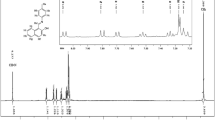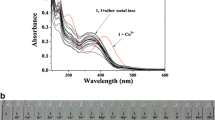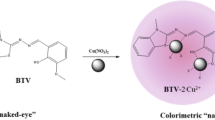Abstract
A new reversible colorimetric and fluorescent chemosensor MMIP based on a simple Schiff base has been successfully synthesized. MMIP exhibited high selectivity and sensitivity towards Ag+, Cu2+ and Hg2+ ions with a short response time in DMSO/H2O (1/1, v/v) solution among various metal ions, and the results could be monitored directly by naked eyes. The binding stoichiometry between MMIP and Ag+/Hg2+/Cu2+ has been determined to be 1:2 by Job’s plot and FT-IR analysis. MMIP could effectively detect Ag+, Cu2+ and Hg2+ over a wide pH range of 3–10. The good linear correlations were obtained in the concentration ranges of 0–20 μM for Ag+, Cu2+ and Hg2+. Thus sensor MMIP could be potentially used for the quantification of Ag+, Cu2+ and Hg2+ in aqueous solution.












Similar content being viewed by others
References
Purcell TW, Peters JJ (1998) Sources of silver in the environment. Environ Toxicol Chem 17:539–546
Míriam ÁC, Manuel MD, Ignacio RG (2008) Slive-mediated synthesis of heterocycles. Chem Rev 108:3174–3198
Sung YM, Wu SP (2014) Highly selective and sensitive colorimetric detection of Ag(I) using N-1-(2-mercaptoethyl)adenine-functionalized gold nanoparticles. Sensors Actuators B Chem 197:172–176
Liu C, Huang SS, Yao HR, He S, Lu Y, Zhao LZ, Zeng XS (2014) Preparation of fluorescein-based chemosensors and their sensing behaviors toward silver ions. RSC Adv 4:16109–16114
Zhang T, Kim B, Levard C, Reinsch BC, Lowry GV, Deshusses MA, Hsu-Kim H (2012) Methylation of mercury by bacteria exposed to dissolved, nanoparticulate, and microparticulate mercuric sulfides. Environ Sci Technol 46:6950–6958
Fitzgerald WF, Lamgorg CH, Hammerschmidt CR (2007) Marine biogeochemical cycling of mercury. Chem Rev 107:641–662
Gutknecht J (1981) Inorganic mercury (Hg2+) transport through lipid bilayer membranes. J Membr Biol 61:61–66
Tchounwou PB, Ayensu WK, Ninashvili N, Sutton D (2003) Environmental exposure to mercury and its toxicopathologic implications for public health. Environ Toxicol 18:149–175
Torrado A, Walkup GK, Imperiali B (1998) Exploiting polypeptide motifs for the Design of Selective Cu(II) ion chemosensors. J Am Chem Soc 120:609–610
Grandini P, Mancin F, Tecilla P, Scrimin P, Tonellato U (1999) Exploiting the self-assembly strategy for the design of selective CuII ion chemosensors. Angew Chem Int Ed 38:3061–3064
Lutsenko S, Gupta A, Burkhead JL, Zuzel V (2008) Cellular multitasking: the dual role of human Cu-ATPases in cofactor delivery and intracellular copper balance. Arch Biochem Biophys 476:22–32
Barnham KJ, Bush AI (2008) Metals in Alzheimer’s and Parkinson’s diseases. Curr Opin Chem Biol 12:222–228
Gaggelli E, Kozlowski H, Valensin D, Valensin G (2006) Copper homeostasis and neurodegenerative disorders (Alzheimer’s, prion, and Parkinson’s diseases and amyotrophic lateral sclerosis). Chem Rev 106:1995–2044
Kozlowski H, Luczkowski M, Remelli M, Valensin D (2012) Copper, zinc and iron in neurodegenerative diseases (Alzheimer’s, Parkinson’s and prion diseases). Coord Chem Rev 256:2129–2141
Wright AT, Anslyn EV (2006) Differential receptor arrays and assays for solution-based molecular recognition. Chem Soc Rev 35:14–28
Liu J, Lu Y (2004) Colorimetric biosensors based on DNAzyme-assembled gold nanoparticles. J Fluoresc 14:343–354
Lee JH, Wang Z, Liu J, Lu Y (2008) Highly sensitive and selective colorimetric sensors for uranyl (UO2 2+): development and comparison of labeled and label-free DNAzyme-gold nanoparticle systems. J Am Chem Soc 130:14217–14226
Choi YW, Park GJ, Na YJ, Jo HY, Lee SA, You GR, Kim C (2014) A single schiff base molecule for recognizing multiple metal ions: a fluorescence sensor for Zn(II) and Al(III) and colorimetric sensor for Fe(II) and Fe(III). Sensors Actuators B Chem 194:343–352
Song EJ, Kim H, Hwang IH, Kim KB, Kim AR, Noh I, Kim C (2014) A single fluorescent chemosensor for multiple target ions: recognition of Zn2+ in 100% aqueous solution and F− in organic solvent. Sensors Actuators B Chem 195:36–43
Gupta VK, Mergu N, Kumawat LK (2016) A new multifunctional rhodamine-derived probe for colorimetric sensing of Cu(II) and Al(III) and fluorometric sensing of Fe(III) in aqueous media. Sensors Actuators B Chem 223:101–113
Goswami S, Aich K, Das S, Mukhopadhyay CD, Sarkar D, Mondal TK (2015) A new visible-light-excitable ICT-CHEF-mediated fluorescence ‘turn-on’ probe for the selective detection of Cd2+ in a mixed aqueous system with live-cell imaging. Dalton Trans 44:5763–5770
Patra GK, Ghorai A, Mondal J, Chandra R (2015) Molecular and electronic structures of donor-functionalized dysprosium pentadienyl complexes. Dalton Trans 44:7109–7113
Li Y, Yu H, Shao G, Gan F (2015) A tetraphenylethylene-based "turn on" fluorescent sensor for the rapid detection of Ag+ ions with high selectivity. J Photoch Photobio A 301:14–19
Kim DH, Seong J, Lee H, Lee KH (2014) Ratiometric fluorescence detection of Hg(II) in aqueous solutions at physiological pH and live cells with a chemosensor based on tyrosine. Sensors Actuators B Chem 196:421–428
**g S, Zheng C, Pu S, Fan C, Liu G (2014) A highly selective ratiometric fluorescent chemosensor for Hg2+ based on a new diarylethene with a stilbene-linked terpyridine unit. Dyes Pigments 107:38–44
Zhang D, Li M, Wang M, Wang J, Yang X, Ye Y, Zhao YF (2013) A rhodamine-phosphonate off-on fluorescent sensor for Hg2+ in natural water and its application in live cell imaging. Sensors Actuators B Chem 177:997–1002
Alizadeha A, Khodaei MM, Hamidi Z, Shamsuddin MB (2014) Naked-eye colorimetric detection of Cu2+ and Ag+ ions based on close-packed aggregation of pyridines-functionalized gold nanoparticles. Sensors Actuators B Chem 190:782–791
Wang M, Yan FY, Zou Y, Chen L, Yang N, Zhou XG (2014) Recognition of Cu2+ and Hg2+ in physiological conditions by a new rhodamine based dual channel fluorescent probe. Sensors Actuators B Chem 192:512–521
Niu Q, Wu X, Zhang S, Li T, Li X (2016) A highly selective and sensitive fluorescent sensor for the rapid detection of Hg2+ based on phenylamine-oligothiophene derivative. Spectrochim Acta Part A 153:143–146
Zhang S, Niu Q, Wu X, Li T, Cui Y, Li X (2015) A fast-responsive fluorescent sensor for Hg2+ with high selectivity and sensitivity in aqueous media. J Fluoresc 25:1543–1548
Xu ZH, Zhang L, Guo R, **ang TC, Wu CZ, Zheng Z, Yang FL (2011) A highly sensitive and selective colorimetric and off-on fluorescent chemosensor for Cu2+ based on rhodamine B derivative. Sensors Actuators B Chem 156:546–552
Raman N, Fathima SSA, Raja JD (2008) Designing, synthesis and spectral characterization of Schiff base transition metal complexes: DNA cleavage and antimicrobial activity studies. J Serb Chem Soc 73:1063–1071
Hitoshi T, Tamao N, Hideyuki A, Manabu F, Takayuki M (1997) Preparation and characterization of novel cyclic tetranuclear manganese (III) complexes: MnIII 4(X-salmphen)6(X-salmphenH2 = N,N′-di-substituted-salicylidene-1,3-dia minobenzene) (X = H, 5-Br). Polyhedron 16:3787–3794
Punniyamurthy T, Karla SJS, Iqbal J (1995) Cobalt(II) catalyzed biomimetic oxidation of hydrocarbons in the presence of dioxygen and 2-methylpropanal. Tetrahedron Lett 36:8497–9500
Bernardo K, Leppard S, Robert A, Commenges G, Dahan F, Meunier B (1996) Synthesis and characterization of new chiral Schiff Base complexes with Diiminobinaphthyl or Diiminocyclohexyl moieties as potential Enantioselective Epoxidation catalysts. Inorg Chem 35:387–396
Yıldırım M, Kaya I (2010) Synthesis of a novel fluorescent Schiff base as a possible Cu(II) ion selective sensor. J Fluoresc 20:771–777
Li HG, Yang ZY, Qin DD (2009) A new Schiff-base type selective fluorescent chemosensor for Cu2+. Inorg Chem Commun 12:494–497
Yan MH, Li TR, Yang ZY (2011) A novel coumarin Schiff-base as a Zn(II) ion fluorescent sensor. Inorg Chem Commun 14:463–465
Liu S, Bi C, Fan Y, Zhao Y, Zhang P, Luo Q, Zhang D (2011) Synthesis, characterization and crystal structure of a new fluorescent probe based on Schiff Base for the detection of zinc (II). Inorg Chem Commun 14:1297–1301
Ghorai A, Mondal J, Chandra R, Patra GK (2015) A reversible fluorescent-colorimetric imino-pyridyl bis-Schiff base sensor for expeditious detection of Al3+ and HSO3 − in aqueous media. Dalton Trans 44:13261–13271
Ghorai A, Mondal J, Chandra R, Patra GK (2015) Exploitation of a simple Schiff base as a ratiometric and colorimetric chemosensor for glutamic acid. Anal Methods 7:8146–8151
Gupta VK, Singh AK, Kumawat LK, Mergu N (2016) An easily accessible switch-on optical chemosensor for the detection of noxious metal ions Ni(II), Zn(II), Fe(III) and UO2(II). Sensors Actuators B Chem 222:468–482
Wang M, Wang LF, Li YZ, Li QX, Xu ZD, Qu DM (2001) Antitumour activity of transition metal complexes with the thiosemicarbazone derived from 3-acetylumbelliferone. Transit Met Chem 26:307–310
Lehn J-M (1995) Supramolecular chemistry: concepts and perspectives. Angew Chem Int Ed Eng 107:2617
Losier P, Zaworotko MJ (1996) A Noninterpenetrated molecular ladder with hydrophobic cavities. Angew Chem Int Ed Eng 35:2779–2782
Aboaly MM, Khalil MMH (2001) Synthesis and spectroscopic study of Cu(II), Ni(II), and Co(II) complexes of the ligand salicylidene-2-amino thiophenol. Spectrosc Lett 34:495–504
Dziembowska T, Jagodzińska E, Rozwadowski Z, Kotfi (2001) Ca M solvent effect on intramolecular proton transfer equilibrium in some N-(R-salicylidene)-alkylamines. J Mol Struct 598:229–234
Khalil MMH, Aboaly MM, Ramadan RM (2005) Spectroscopic and electrochemical studies of ruthenium and osmium complexes of salicylideneimine-2-thiophenol Schiff base. Spectrochim Acta A 61:157–161
Pearson RG (1963) Hard and soft acids and bases. J Am Chem Soc 8:3533–3539
Sureshan CA, Bhaltacharya PK (1997) Study of CuII binuclear complexes of binucleating hexadentate ligands. Polyhedron 16:489–494
Acknowledgements
This work was financially supported by the National Natural Science Foundation of China (no. 21376125/51402157), and Program for Scientific Research Innovation Team in Colleges and Universities of Shandong Province.
Author information
Authors and Affiliations
Corresponding author
Additional information
Shanshan Zhang and **ngxing Wu contributed equally to this work.
Electronic supplementary material
ESM 1
(DOC 538 kb)
Rights and permissions
About this article
Cite this article
Zhang, S., Wu, X., Niu, Q. et al. Highly Selective and Sensitive Colorimetric and Fluorescent Chemosensor for Rapid Detection of Ag+, Cu2+ and Hg2+ Based on a Simple Schiff Base. J Fluoresc 27, 729–737 (2017). https://doi.org/10.1007/s10895-016-2005-y
Received:
Accepted:
Published:
Issue Date:
DOI: https://doi.org/10.1007/s10895-016-2005-y




